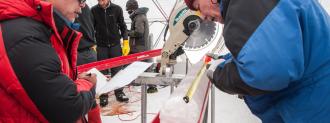Ohio State scientists have discovered a trove of ancient viruses in glacier ice samples taken from the Tibetan Plateau. Dating back nearly 15,000 years, the majority of the viruses are completely new to science — and the technique with which they were isolated from the samples may have implications for not only understanding the past, but also the present and future of environments.
“Glacier ice archives information, including microbiology, that helps reveal paleoclimate histories and predict future climate change,” the researchers wrote in their study, published in Microbiome.
And viruses, believe it or not, play a key role in those predictions.
Ancient viruses, current research: “The glaciers in western China are not well-studied, and our goal is to use this information to reflect past environments. And viruses are a part of those environments,” Zhi-Ping Zhong, the study’s lead author and a researcher at Ohio State’s Byrd Polar and Climate Research Center, said.
As those mysterious glaciers gradually formed over millennia, they locked in aspects of their environment, including “many, many viruses,” Zhong said.
He examined ice cores taken from high above sea level back in 2015. Those cores’ layers essentially serve as a snapshot of their surrounding environment. By studying them, researchers can piece together information about atmospheric composition, climate, and viruses — among other things.
Don’t worry about an ancient, icy infection escaping Ohio and wreaking havoc.
Studying the genomes of multiple organisms or viruses at the same time, called metagenomic research, could give us genetic pictures of ancient viruses in those samples.
However, these methods aren’t used very often, researchers say, largely because contamination of the samples with modern microbes is such a problem. There’s just not many ancient virus particles in these samples to begin with, and there is a ton of bacteria, viruses, cells, DNA, and other junk in the air around us.
Pure ice: To overcome this issue, Zhong’s team developed a novel way to sterilize the ice cores.
They removed prosciutto-thin, half-centimeter layers from the outer surface of the ice with an array of techniques — first using a bandsaw, then with an ethanol rinse, and finally a sterile-water wash, New Atlas explained, a process they tested on artificial ice cores they covered in viruses, bacteria, and DNA.
“Controlled sampling experiments drastically reduced mock contaminants including bacteria, viruses, and free DNA to background levels,” the team wrote, and they were able to study the inner ice cores contaminant-free.
When they did, they found the genetic codes of 33 different viruses, including four we’ve already identified. Those other 28, however — those are new. The team’s analysis suggests they originated in soil and plants, not animals. And half of them appear to not just have weathered being frozen; they may have loved it.
“These viruses have signatures of genes that help them infect cells in cold environments.”
Matthew Sullivan
“These are viruses that would have thrived in extreme environments,” Matthew Sullivan, study co-author and director of Ohio State’s Center of Microbiome Science, said.
(And don’t worry about some icy infection escaping Columbus and wreaking havoc; the viruses are immediately “killed” by the team’s DNA extraction process, Sullivan told Gizmodo.)
Frigid future hunts: The study of glacier-preserved ancient viruses is still a relatively nascent field. According to Ohio State, only two previous studies have identified viruses locked in primeval ice. The field could prove to be an important one, however, especially considering how climate change is currently altering the risk of zoonotic diseases spilling over from animals to humans.
“We know very little about viruses and microbes in these extreme environments, and what is actually there,” Lonnie Thompson, senior author and research scientist at the Byrd Center, said. “The documentation and understanding of that is extremely important: How do bacteria and viruses respond to climate change? What happens when we go from an ice age to a warm period like we’re in now?”
Those ice-loving ancient viruses — and the method used to discover them — may also have implications as we hunt for life in icy environments.
“These viruses have signatures of genes that help them infect cells in cold environments – just surreal genetic signatures for how a virus is able to survive in extreme conditions,” Sullivan said in a statement.
“These are not easy signatures to pull out, and the method that Zhi-Ping developed to decontaminate the cores and to study microbes and viruses in ice could help us search for these genetic sequences in other extreme icy environments – Mars, for example, the moon, or closer to home in Earth’s Atacama Desert.”
We’d love to hear from you! If you have a comment about this article or if you have a tip for a future Freethink story, please email us at [email protected].






